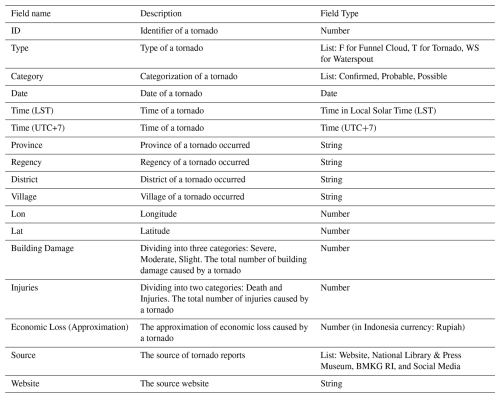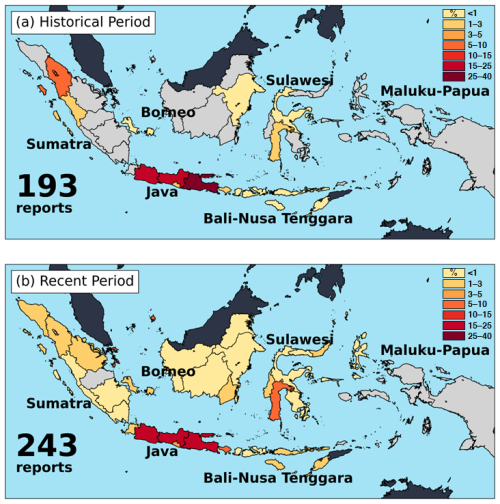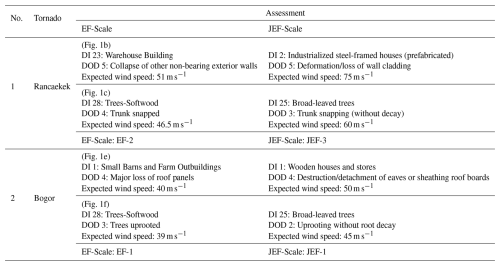the Creative Commons Attribution 4.0 License.
the Creative Commons Attribution 4.0 License.
Indonesia tornado database: tornado climatology of Indonesia
Irfans Maulana Firdaus
Takeshi Yamazaki
Muhammad Rais Abdillah
Edi Riawan
The climatology of tornadoes, waterspouts, and funnel clouds for Indonesia is compiled into a new tornado database based on newspaper archives, online news, and social media (X, YouTube), covering the period from 1800 to 2024. We present the analysis over two periods: (i) historical and (ii) recent periods. The climatology includes the annual, monthly, diurnal, and geographical data for tornado cases. Based on a review of 47 669 reports mentioning tornadoes, we identified 436 tornado cases with sufficient evidence to be classified as tornado events. In the recent period (2010–2024), the annual frequency of tornadoes was 16.20 cases yr−1, while in the historical period (1800–2009), the annual frequency was 1.10 cases yr−1. Tornadoes were mostly documented in Java Island, followed by Sumatra and Sulawesi. The monthly variability of tornadoes shows a maximum during November, followed by December and January. The peak of the diurnal cycle of tornado cases is between 13:00 and 17:00 Local Solar Time.
- Article
(1601 KB) - Full-text XML
-
Supplement
(750 KB) - BibTeX
- EndNote
Tornadoes are among the most destructive meteorological phenomena, causing significant damage to buildings, infrastructure, and the surrounding landscape. The climatology of tornadoes is crucial for understanding the dynamics and characteristics of tornado occurrences, as well as for enhancing risk assessment and mitigation strategies. Knowledge of tornado characteristics can enhance community response to the tornado threats and help identify vulnerable populations (Johnson et al., 2021). Several open databases have been published online by countries, including the European countries (European Severe Weather Database or ESWD, Dotzek et al., 2009; https://eswd.eu/, last access: 21 March 2025), the United States (National Centers for Environmental Information, NCEI; http://www.ncdc.noaa.gov/, last access: 21 March 2025), Canada (Northern Tornadoes Project, NTP; https://uwo.ca/ntp/, last access: 21 March 2025), and Japan (Japan Meteorological Agency, JMA; https://www.data.jma.go.jp/stats/data/bosai/tornado/list.html, last access: 21 March 2025).
On the other hand, tornado climatologies have been published for several countries across Europe (Antonescu et al., 2016), Northern Eurasia (Chernokulsky et al., 2020), South America (Veloso-Aguila et al., 2024), Australia (Kounkou et al., 2009), and Asia countries such as Japan (Niino et al., 1997; Kawazoe et al., 2023), China (Chen et al., 2018; Zhang et al., 2023), India-Pakistan (Bhan et al., 2016), and the Philippines (Capuli, 2024). Antonescu et al. (2016) summarizes the tornado observation for 30 countries across Europe (see their Appendix A). In addition to local meteorological agency sources for tornado reports, other primary sources include old newspaper archives, online news, and social media (Newark, 1984; Paul, 2001; Rauhala et al., 2012; Kahraman and Markowski, 2014; Matsangouras et al., 2014; Antonescu and Bell, 2015; Veloso-Aguila et al., 2024). The term for a tornado may vary from one country to another. For example, words such as kasırga, fırtına, and siklon are described as tornado events in Turkey (Kahraman and Markowski, 2014). Moreover, in Romania, they use words like uragan/orcan, trombă, tornadă, and vârtej to describe a tornado events.
The occurrence of tornadoes in Indonesia is rare (Maas et al., 2024) compared to mid-latitudes regions such as the United States. Nevertheless, their impact can still be devastating. Figure 1 shows the tornado cases that occurred in Indonesia. A tornado hit Rancaekek, Sumedang, West Java on 21 February 2024, damaged over 1000 buildings and caused at least 47 injuries (Fig. 1a–c). On 6 December 2018, a tornado occurred in Bogor, West Java, resulting in damage to 854 buildings (Fig. 1d–f). However, tornado reports in Indonesia have not been systematically recorded, unlike in countries such as the United States and those in Europe.
This paper aims to identify tornado cases in Indonesia from numerous scattered reports and to investigate basic climatological characteristics of the tornadoes in Indonesia. The identified tornadoes are published in an open repository that can catalyze future tornado studies in the tropics. This paper is organized as follows: Sect. 2 presents the data and methodology related to the collection and categorization of tornado reports for the database. Section 3 presents the result of the tornado climatology for Indonesia. Section 4 presents a discussion about the limitation, the relationship between convective precursor and tornado, and tornado rating differences. The last section, Sect. 5 provides a conclusion.
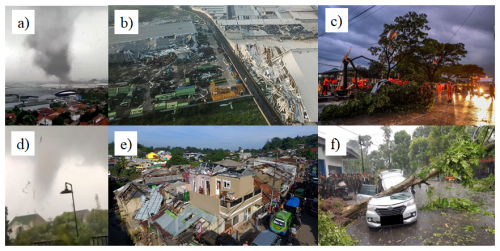
Figure 1(a) Tornado in Rancaekek, West Java, on 21 February 2024 (Jawa Pos, 2024), (b, c) damage caused by a tornado in Rancaekek (Tempo, 2024; RRI, 2024), (d) Tornado in Bogor City, West Java on 6 December 2018 (Hidayatullah, 2018), (e, f) damage caused by a tornado in Bogor City (Tempo, 2018; Kompas, 2018). The figures are downloaded from news article online.
This section describes the development of the tornado database for Indonesia. The term “tornado” is not commonly used in Indonesia, as it has a local name, angin puting beliung, which translates to “rotating wind”. In this article, we use the term “tornado” instead of angin puting beliung and address the criteria and definition of a tornado. With a clear definition of tornadoes, we created a new tornado database by collecting historical reports from archives, including newspapers and social media. Finally, we analyze the climatology of tornadoes in Indonesia.
The Meteorological, Climatological, and Geophysical Agency of Indonesia (BMKG RI) defines a tornado as “a rotating, strong wind originating from a cumulonimbus cloud, occurring for a short period”. Meanwhile, the National Disaster Management Authority of Indonesia (BNPB RI) defines a tornado as “a sudden, rotating, strong wind with a center and spiral-like appearance, extending to the ground and dissipating within a short time (3–5 min)”. Given these differing definitions, we address the definition of a tornado. In this article, the tornado definition is adopted from American Meteorological Society (2024). A tornado is defined as “a rapidly rotating column of air that extends from the surface to the base of a cumuliform cloud and is often visible as a funnel cloud”. Additionally, this definition is extended to include all waterspouts, whether or not they make landfall, in line with the tornado definition by Rauhala et al. (2012).
The criteria for evaluating tornado cases were adopted and modified from Rauhala et al. (2012) (Table 1). We made additions and modifications to the “probable” and “possible” categories. An eyewitness testimony that reported observing rotating winds and/or a column of air directly was included in the “probable” category, while an eyewitness testimony that reported hearing thunder and observing hail directly was placed in the “possible” category. A report is categorized as a tornado case if any of the criteria are satisfied. All criteria were accepted in the new database, but only confirmed and probable tornado cases were analyzed for tornado climatology in Indonesia (Rauhala et al., 2012; Kahraman and Markowski, 2014).
The tornado climatology in Indonesia was divided into two different periods. The first period is the historical period, starting in 1800 and ending in 2009. The second period is the recent period, spanning from 2010 to 2024, following the release of the BMKG regulation on the “Standard Operating Procedure for Early Warning Implementation, Reporting, and Dissemination of Extreme Weather Information”, as well as the period during which the Internet became widely used. The periods of tornado report sources are illustrated in Fig. 2.
2.1 Historical period
Tornado reports for the historical period were collected from old newspaper archives. There are two sources used: (1) Dutch old newspaper archives (1800–1957), which were accessed via the online website (https://www.delpher.nl/, last access: 6 August 2025) and (2) the National Library and Press Museum newspaper archives (1945–2009), which were accessed via the online website (https://mpn.kominfo.go.id/arsip/, last access: 21 January 2025; http://khastara.perpusnas.go.id, last access: 24 March 2025). The Dutch newspaper archives were searched using three keywords: (a) tornado, (b) windhoos, and (c) wervelwind. We filtered the archive newspapers by region, specifically Nederlands-Indie/Indonesie. The archived newspapers included Java Govt. Gazette, De Locomotief, Javasche Courant, Deli Courant, Soerabaiasch-Handelsblad, Batavia Nieuwsblad, De Preangerbode, De Indische Courant, Het Nieuws Van Den Dag, De Sumatra Post, Java Bode, Sumatra-Courant, etc. The newspaper archives from the National Library and Press Museum were searched using two keywords: (a) angin puyuh and (b) angin puting beliung.

Figure 2Period of tornado reports sources. There are four main sources: (i) the Dutch old newspaper archives, (ii) National Library and Press Museum, (iii) BMKG RI extreme weather database, and (iv) Social media.
In total, 9930 reports were collected from the Dutch old newspaper archives and 18 958 reports from the National Library and Press Museum newspaper archives (Table 2). A total of 193 tornado reports were accepted into the database. The first recorded tornado case in Indonesia was reported by the Java Govt. Gazette. The tornado occurred in Surabaya, East Java, on 7 December 1815. The tornado passed through the town, resulting in one house being destroyed, with one fatality and four people injured. However, this case was categorized as a possible tornado. The first probable tornado case occurred in Temanggung, Central Java, on 30 December 1834. The tornado struck a large tree, destroyed 70 houses, and damaged rice fields. Fortunately, there were no fatalities in this disaster.
2.2 Recent period
The primary sources for the recent period were the newspaper archives of the National Library and Press Museum (2010–2024), the BMKG RI extreme weather database (2012–2024), and social media (2010–2024, including X, YouTube, and News). The BMKG RI extreme weather database collects internet news and compiles it into an online database, accessible at https://pikacu.bmkg.go.id/, last access: 25 June 2025. Tornado reports from social media platforms, such as X, were used to improve the quality of the reports (Baranowski et al., 2020). The tornado cases were extracted through data mining using Python and Generative AI (Gemini Application Programming Interface – API) to eliminate noisy data, such as metaphorical terms or non-weather-related usage. The keywords used for mining the tornado cases were similar to those used in the old newspaper archives. For each identified case, the corresponding social media URLs were collected to enable manual verification and validation. Any unrelated or unverifiable sources were excluded from the dataset. After that, we categorized the tornado cases based on the criteria in Table 1. In cases where multiple sources reported the same event, the report was classified based on the most reliable source, preferably those accompanied by photographs, videos, or damage surveys. In total, there were 1832 reports from the BMKG RI extreme weather database and 17 549 reports from social media (Table 2). During the recent period, 243 tornado cases were added to the database.
2.3 Indonesia Tornado Database
Indonesia has no tornado database yet. While the BMKG RI provides an extreme weather database via its online website at https://pikacu.bmkg.go.id/, last access: 25 January 2025, and the BNPB RI maintains a disaster database that can be accessed online at https://gis.bnpb.go.id/, last access: 6 January 2025, neither offers detailed information on tornado cases. The BMKG RI's extreme weather database collects news from the internet and compiles it with other disaster data, such as floods, landslides, hail, strong winds, and heavy rainfall. On the other hand, the BNPB RI disaster database does not explicitly mention tornadoes, as tornadoes are categorized under extreme weather events, alongside strong winds, hail, tropical cyclones, and extreme temperature changes. Therefore, we developed the Indonesia Tornado Database to document the tornado cases that have occurred in Indonesia (Firdaus and Iswahyudi, 2025). Table 3 shows the attributes of the Indonesia Tornado Database.
3.1 Decadal and Annual Frequency
The total number of tornado cases in Indonesia, including confirmed and probable cases, from 1800 to 2024, is about 436 cases. More than half of these cases (243 cases) occurred in the last 15 years (Fig. 3). The increasing trend in tornado cases is likely attributed to advances in technology, such as the widespread use of the internet and social media. Therefore, it is not possible to determine whether tornadoes, as a natural hazard, are increasing in frequency.
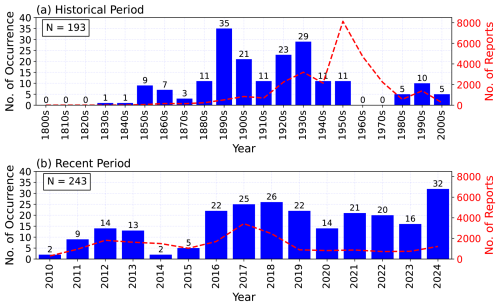
Figure 3Annual frequency of tornado cases and number of tornado reports: (a) Historical period from 1830s until 2000s (per decades) and (b) Recent period from 2010 until 2024.
In the historical period, the total number of tornado cases is 193, which occurred between 1834 and 2009 (175 years). It means the average number of tornado cases is 1.10 tornadoes per year. There was a significant increase in tornado reports from the 1830s to the 1870s, followed by another rise from the 1880s to the 1950s. This increase is presumed to be due to the growing number of newspaper publishers during that period (from 15 publishers to 20 publishers). A break in tornado cases is found from the 1960s to the 1970s. We speculate that this gap resulted from a shift from Dutch newspapers to Indonesian newspapers, which led to changes in the management of newspaper content. After the 1980s, tornado reports remained relatively constant until the 2000s.
On the other hand, the total number of tornado cases is about 243 tornadoes between 2010 and 2024 (15 years), showing an increase during this period. The average number of tornadoes is about 16.20 tornadoes per year. A notable difference is observed between the periods before and after 2016. We speculate that the increase in tornado cases is due to the widespread use of the internet and social media. Additionally, public awareness of extreme weather events has increased, which has likely influenced the tornado database in recent years (Antonescu et al., 2016).
3.2 Spatial Distribution
The spatial distribution of tornado cases is shown in Fig. 4 for six regions: (i) Sumatra, (ii) Java, (iii) Borneo, (iv) Sulawesi, (v) Bali-Nusa Tenggara, and (vi) Maluku-Papua. In our database, tornado cases are most frequent in Java for both periods. The lowest occurrence of tornadoes was reported in the Maluku-Papua region. According to historical reports, over 75 % of tornado reports originated from Java, with fewer reports from northern Sumatra, eastern Borneo, central Sulawesi, and the Bali-Nusa Tenggara region. No tornado reports were recorded from Maluku-Papua. We speculate that the higher frequency of tornado reports in Java and the lower frequency in certain regions are due to: (i) the newspaper publishers and (ii) the population density. The old newspaper archives were primarily found in large cities, such as Java Govt. Gazette from Batavia (now Jakarta) in Java, De Locomotief from Surabaya in Java, Deli Courant from Surabaya in Java, De Preangerbode from Bandung in Java, De Sumatra Post from Medan in Sumatra, and Sumatra-Courant from Padang in Sumatra. Additionally, Indonesia's population is not evenly distributed (Fig. S1 in the Supplement). Over 63.8 % of Indonesia's population lived in Java, and 17.4 % lived in Sumatra.
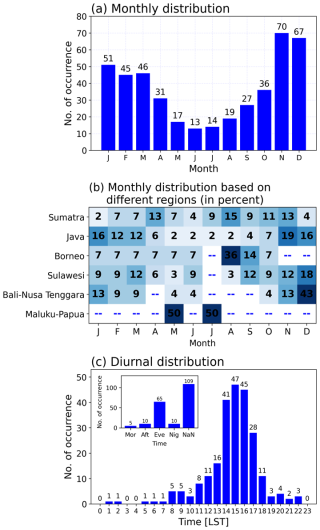
Figure 5(a) Monthly distribution, (b) percentage of monthly distribution based on different regions, and (c) diurnal distribution of tornado cases in Indonesia for the historical and recent period. The percentage is calculated by dividing the number of tornado cases for a specific month and region by the total number of tornado cases in that region. In the inset of panel (c), “Mor”, “Aft”, “Eve”, “Nig”, “NaN” represent morning, afternoon, evening, night, and missing data, respectively.
In the recent period, tornado reports have been more evenly distributed compared to the historical period, although tornado reports remain most frequent in Java. There has been an increase in tornado reports across Sumatra, Borneo, Sulawesi, and Bali-Nusa Tenggara. The usage of the internet and population growth are the main reasons for the increase in tornado reports during this period (Anderson et al., 2007). The population growth in Sumatra, Borneo, Sulawesi, and Maluku-Papua has increased by 2–5 times between 1971 and 2024 (Fig. S2). Over the past 15 years, the internet and social media have been widely used globally, including in Indonesia. For example, the number of X users in Indonesia was about 29.4 million in 2012 (Carley et al., 2015), and this number is expected to have increased since then. This widespread use of the internet means that information, including disaster reports, can be disseminated easily (Baranowski et al., 2020).
3.3 Monthly and Diurnal Distribution
Figure 5 shows the monthly and diurnal distribution of tornado cases in Indonesia from 1834 to 2024. Approximately 64 % of tornado cases occurred between November and March (Fig. 5a). This pattern is coinciding with the Asia-Australia monsoon system, which is active during the boreal winter (Wheeler and McBride, 2005). Tornadoes occurred most frequently in November and least frequently in June.
The percentage of monthly distribution for each region is shown in Fig. 5b. The monthly peak of tornado cases varies by region. The peak differences among regions coincide with the precipitation pattern in Indonesia (Aldrian and Susanto, 2003). Java and Bali-Nusa Tenggara have a peak of tornado cases during the November–December–January–February season, while Maluku-Papua has a peak between May–July, and Borneo has a peak between July–August. Sulawesi has peak tornado cases in March, September, and December. Sumatra has peak tornado cases in April, August, and November. These patterns are a result of the distinct precipitation patterns characteristic of these islands.
The diurnal distribution of tornado cases in Indonesia was placed into 1 h bins in Local Solar Time (LST): 00:00–00:59, 01:00–01:59, etc (Fig. 5c). The old newspaper archives sometimes do not provide detailed information regarding the timing of tornado occurrences. Therefore, we categorized that data into five terms: Mor (morning), Aft (afternoon), Eve (evening), Nig (night), and NaN (no information available). Tornadoes were most frequently reported during the daytime between 13:00–17:00 LT and in the evening, with approximately 56 % of tornado cases occurring during this time. A smaller portion of tornado cases occurred in the early morning and at night. This pattern coincides with the diurnal cycle of precipitation in Indonesia. Peatman et al. (2021) stated that the diurnal cycle of precipitation in Indonesia is driven by temperature contrasts between land and sea, which create deep convection in the afternoon. Additionally, the complex topography in Indonesia can influence and enhance convection through orography (Peatman et al., 2021; Firdaus et al., 2024).
4.1 Limitation
The tornado cases were collected from four primary sources: (i) old newspaper archives from the website https://delpher.nl/, last access: 6 August 2025, (ii) the National Library and Press Museum, (iii) the BMKG RI extreme weather database, and (iv) Social media. We realized that these sources can lead to a bias in the spatiotemporal distribution of tornado cases in Indonesia. Not all the old newspapers, both from the website and the National Library and Press Museum, were available for analysis. The description of the event was also limited, which could result in errors regarding location and time. The coverage of the old newspaper could result in bias in the spatial distribution of tornado cases, as we speculate in Sect. 3.2 that the old newspapers were primarily found in the big cities, such as Padang and Medan in North Sumatra, and Jakarta, Surabaya, and Bandung in Java. Reports from old newspapers may also have been influenced by editorial choices or public interest. The BMKG RI extreme weather database and social media could also result in bias, especially in spatial events, because it depends on the observer or people who reported the tornado. The population density in Indonesia is not distributed spatially (see Fig. S1 in the Supplement). For example, the Maluku-Papua and the central Borneo have population density around 0–50 person km−2 compared to other regions, such as Java, that have a population density of over 500 person km−2.
4.2 Influence of Convective Precursors
Previous studies have examined the influence of convective precursors on tornadic storms, such as the Madden-Julian Oscillation (MJO) (Barrett and Gensini, 2013; Tippett, 2018; Veloso-Aguila et al., 2024) and the El Niño–Southern Oscillation (ENSO) (Allen et al., 2015). Maritime Continent (MC) convective activity, especially Indonesia, is influenced by various phenomena, such as MJO, ENSO, Indian Ocean Dipole (IOD), monsoon, and cold surge (Yoneyama and Zhang, 2020). Muhammad et al. (2021) showed that during phases 2 through 4 of active MJO, convection develops in the MC and can increase the extreme precipitation probability. Kurniadi et al. (2021) found that ENSO and IOD can affect extreme precipitation in Indonesia. The impact of ENSO on extreme precipitation is more pronounced between June and November, but less significant from December to May. In contrast, the IOD has a significant effect on extreme precipitation only during the June to November period. Chang et al. (2005) showed that monsoon can influence the increasing and decreasing precipitation in MC. Cold surges also influence the precipitation in MC (Hattori et al., 2011). These phenomena modulate convective activity, which can subsequently lead to extreme precipitation. However, there are limited studies that specifically examine how synoptic-scale conditions modulate tornado activity in tropical regions. Therefore, further investigation is needed to assess the influence of convective precursors on tornado occurrence in Indonesia.
4.3 Indonesian Tornado Rating
The rating of tornadoes is critically important for understanding and mitigating the impacts of these severe weather events. Tornado ratings typically use the Fujita scale (Fujita, 1973) or the T-Scale (Meaden, 1976; Feuerstein et al., 2011), both of which are based on the severity of damage caused by strong winds. The Fujita Scale was later updated to the Enhanced Fujita Scale (EF-Scale) in 2007 (McDonald and Mehta, 2006). The EF-Scale utilizes damage indicators (DIs), with each DI having several degrees of damage (DODs). Various adaptations of the EF-Scale have been developed in different countries, such as in Canada (Sills et al., 2014; Environment Canada’s Weather Service, 2018), known as the EF-Scale Canada, and in Japan (Japan Meteorological Agency, 2015), referred to as the Japanese EF-Scale (JEF-Scale). These adaptations modify the DI and DOD based on regional factors such as building structures, vegetation, and construction materials, which vary by country.
In Indonesia, there is currently no standardized procedure to assess tornado damage, and as a result, tornadoes in the country are not rated. Two recent tornado events, the Tornado Bogor (2018) and Tornado Rancaekek (2024) (Fig. 1), did not have a rating. Figure 1 shows the appearance of the Tornado Rancaekek and Tornado Bogor with the damaged buildings and trees caused by these events. The Tornado Rancaekek damaged 1177 houses and buildings, while the Tornado Bogor damaged 1697 houses and buildings.
Table 4 presents the tornado assessment for Tornado Rancaekek and Tornado Bogor based on both the EF-Scale and the JEF-Scale. Both scales use the DI and DOD to assess the expected wind speed of a tornado, assigning ratings based on the highest wind speed. According to the EF-Scale, Tornado Rancaekek can be categorized as EF2, as it caused significant damage to a factory building, while Tornado Bogor is categorized as EF1, due to the loss of roof covering materials on buildings. On the other hand, according to the JEF-Scale, Tornado Rancaekek is classified as JEF3, while Tornado Bogor is categorized as JEF1.
It is clear from the evidence above that there is a difference between the EF-Scale and the JEF-Scale, which is caused by their DI and DOD classifications. Indonesia has distinct building and structural characteristics compared to countries such as the United States and Japan. For instance, many houses in Indonesia are constructed with wood and brick, and roofs are often made of tiles. These factors influence the DOD classification, which can lead to overestimation of the tornado's rating when applying the EF-Scale or JEF-Scale. Therefore, it is recommended that Indonesia develop its tornado scale, tailored to its unique construction practices, to assess and rate tornado events in Indonesia more accurately.
This paper presents what is believed to be the first climatological analysis of tornado cases in Indonesia to date. The tornado cases were collected from four primary sources from 1800 to 2024: (i) old newspaper archives from the website https://delpher.nl/, last access: 6 August 2025, (ii) the National Library and Press Museum, (iii) the BMKG RI extreme weather database, and (iv) Social media. The tornado climatology was divided into two periods: (i) historical period (1800–2009) and (ii) recent period (2010–2024). The main conclusion of the study can be briefly summarized as follows:
-
A total of 436 tornado cases occurred from 1800 to 2024. In the historical period (1800–2009), tornadoes were reported in 193 cases, or approximately one tornado yr−1. In the recent period (2010–2024), there were 243 cases, or 16–17 tornadoes yr−1.
-
The most frequent tornado reports were reported in Java for both periods, followed by Sumatra, Sulawesi, Bali-Nusa Tenggara, Borneo, and Maluku-Papua. It is speculated due to population density and the widespread use of the internet.
-
Tornado cases mainly occurred during November–December–January–February–March, coinciding with the precipitation pattern in Indonesia. The majority of tornado cases occurred between 13:00 and 17:00 LT and in the evening.
The Indonesian tornado database developed in this study can help fill the information gap regarding severe weather, particularly tornadoes, and provide a better understanding of tornadoes in the tropical maritime region. The next step in exploring tornadoes in Indonesia is to examine the characteristics of environmental conditions associated with tornadoes, as this is crucial for improving prediction and risk assessment in Indonesia.
The Indonesia Tornado Database is available at https://doi.org/10.5281/zenodo.15099438 (Firdaus and Iswahyudi, 2025). The old newspaper archives were collected and saved by the author. These are available upon request from the corresponding author on reasonable request.
The supplement related to this article is available online at https://doi.org/10.5194/nhess-25-4331-2025-supplement.
IMF: conceptualization, data curation, methodology, writing (original draft). TY: supervision, writing (review and editing). MRA: supervision, writing (review and editing). ER: supervision, writing (review and editing).
The contact author has declared that none of the authors has any competing interests.
Publisher’s note: Copernicus Publications remains neutral with regard to jurisdictional claims made in the text, published maps, institutional affiliations, or any other geographical representation in this paper. While Copernicus Publications makes every effort to include appropriate place names, the final responsibility lies with the authors. Views expressed in the text are those of the authors and do not necessarily reflect the views of the publisher.
The first author was funded by a scholarship from Japan International Cooperation Agency (JICA) under Human Resources Development in Science, Technology and Innovation Program. The first author would like to thank National Press Museum and National Library who provide the old newspaper archives. Thank to Ridha Fatony Iswahyudi for helping the first author to collect the tornado reports. Finally, we extend thanks to the anonymous reviewers for their invaluable feedback and suggestions.
This research was supported by Japan International Cooperation Agency (JICA) under Human Resources Development in Science, Technology and Innovation. This research is also partly funded by “Program Riset ITB tahun 2025” (grant number: 533E/IT1.A/SK-KP/2025) and “Program PPMI FITB 2025” (file number: FITB.PPMI-1-01-2025).
This paper was edited by Piero Lionello and reviewed by two anonymous referees.
Aldrian, E. and Susanto, R. D.: Identification of three dominant rainfall regions within Indonesia and their relationship to sea surface temperature, International Journal of Climatology, 23, 1435–1452, https://doi.org/10.1002/joc.950, 2003. a
Allen, J., Tippett, M., and Sobel, A.: Influence of the El Niño/Southern Oscillation on tornado and hail frequency in the United States, Nature Geoscience, 8, 278–283, https://doi.org/10.1038/ngeo2385, 2015. a
American Meteorological Society: Tornado, https://glossary.ametsoc.org/wiki/Tornado (last access: 20 August 2024), 2024. a
Anderson, C. J., Wikle, C. K., Zhou, Q., and Royle, J. A.: Population Influences on Tornado Reports in the United States, Weather and Forecasting, 22, 571–579, https://doi.org/10.1175/WAF997.1, 2007. a
Antonescu, B. and Bell, A.: Tornadoes in Romania, Monthly Weather Review, 143, 689–701, https://doi.org/10.1175/MWR-D-14-00181.1, 2015. a
Antonescu, B., Schultz, D. M., Lomas, F., and Kühne, T.: Tornadoes in Europe: Synthesis of the Observational Datasets, Monthly Weather Review, 144, 2445–2480, https://doi.org/10.1175/MWR-D-15-0298.1, 2016. a, b, c
Baranowski, D. B., Flatau, M. K., Flatau, P. J., Karnawati, D., Barabasz, K., Labuz, M., Latos, B., Schmidt, J. M., Paski, J. A. I., and Marzuki: Social-media and newspaper reports reveal large-scale meteorological drivers of floods on Sumatra, Nature Communications, 11, https://doi.org/10.1038/s41467-020-16171-2, 2020. a, b
Barrett, B. S. and Gensini, V. A.: Variability of central United States April–May tornado day likelihood by phase of the Madden-Julian Oscillation, Geophysical Research Letters, 40, 2790–2795, https://doi.org/10.1002/grl.50522, 2013. a
Bhan, S., Paul, S., Chakravarthy, K., Saxena, R., Ray, K., and Gopal, N.: Climatology of Tornadoes over northwest India and Pakistan; and Meteorological Analysis of recent Tornadoes over the Region, Journal of Indian Geophysical Union, Vol. 20, 75–88, 2016. a
Capuli, G.: Project Severe Weather Archive of the Philippines (SWAP) Part 1: Establishing a Baseline Climatology for Severe Weather across the Philippine Archipelago, Annals of Geophysics, 67, GC553, https://doi.org/10.4401/ag-9151, 2024. a
Carley, K., Malik, M., Kowalchuck, M., Pfeffer, J., and Landwehr, P.: Twitter usage in Indonesia, Nature Communications, https://doi.org/10.2139/ssrn.2720332, 2015. a
Chang, C.-P., Wang, Z., McBride, J., and Liu, C.-H.: Annual Cycle of Southeast Asia–Maritime Continent Rainfall and the Asymmetric Monsoon Transition, Journal of Climate, 18, 287–301, https://doi.org/10.1175/JCLI-3257.1, 2005. a
Chen, J., Cai, X., Wang, H., Kang, L., Zhang, H., Song, Y., Zhu, H., Zheng, W., and Li, F.: Tornado climatology of China, International Journal of Climatology, 38, 2478–2489, https://doi.org/10.1002/joc.5369, 2018. a
Chernokulsky, A., Kurgansky, M., Mokhov, I., Shikhov, A., Azhigov, I., Selezneva, E., Zakharchenko, D., Antonescu, B., and Kühne, T.: Tornadoes in Northern Eurasia: From the Middle Age to the Information Era, Monthly Weather Review, 148, 3081–3110, https://doi.org/10.1175/MWR-D-19-0251.1, 2020. a
Dotzek, N., Groenemeijer, P., Feuerstein, B., and Holzer, A. M.: Overview of ESSL's severe convective storms research using the European Severe Weather Database ESWD, Atmospheric Research, 93, 575–586, https://doi.org/10.1016/j.atmosres.2008.10.020, 2009. a
Environment Canada’s Weather Service: Enhanced Fujita scale for wind damage, https://www.canada.ca/en/environment-climate-change/services/seasonal-weather-hazards/enhanced-fujita-scale-wind-damage.html (last access: 31 March 2025), 2018. a
Feuerstein, B., Groenemeijer, P., Dirksen, E., Hubrig, M., Holzer, A. M., and Dotzek, N.: Towards an improved wind speed scale and damage description adapted for Central Europe, Atmospheric Research, 100, 547–564, https://doi.org/10.1016/j.atmosres.2010.12.026, 2011. a
Firdaus, I. M. and Iswahyudi, R. F.: Indonesia Tornado Database, Zenodo [data set], https://doi.org/10.5281/zenodo.15233333, 2025. a, b
Firdaus, I. M., Trilaksono, N. J., and Yamazaki, T.: Mechanism of Initiation and Regeneration of Convective Cell in Bandung Basin, Indonesia, Geoscience Letters, 11, https://doi.org/10.1186/s40562-024-00359-1, 2024. a
Fujita, T. T.: Tornadoes Around the World, Weatherwise, 26, 56–62, 78–83, 1973. a
Hattori, M., Mori, S., and Matsumoto, J.: The Cross-Equatorial Northerly Surge over the Maritime Continent and Its Relationship to Precipitation Patterns, Journal of the Meteorological Society of Japan. Ser. II, 89A, 27–47, https://doi.org/10.2151/jmsj.2011-A02, 2011. a
Hidayatullah: Angin Kencang Bogor, 1 Korban Jiwa, Pohon Tumbang, Rumah Rusak, https://hidayatullah.com/berita/nasional/2018/12/06/156075/angin-kencang-bogor-1-korban-jiwa-pohon-tumbang-rumah-rusak.html (last access: 27 August 2024), 2018. a
Japan Meteorological Agency: Guidelines for the Japanese Enhanced Fujita Scale, Tech. rep., Japan Meteorological Agency, 10–11, 2015. a
Jawa Pos: Peneliti BRIN Ungkap Penyebab Angin Puting Beliung di Rancaekek Bandung Mirip Tornado, https://www.jawapos.com/nasional/014330527/peneliti-brin-ungkap-penyebab-angin-puting-beliung-di-rancaekek-bandung-mirip-tornado (last access: 27 August 2024), 2024. a
Johnson, V. A., Klockow-McClain, K. E., Peppler, R. A., and Person, A. M.: Tornado Climatology and Risk Perception in Central Oklahoma, Weather, Climate, and Society, 13, 743–751, https://doi.org/10.1175/WCAS-D-20-0137.1, 2021. a
Kahraman, A. and Markowski, P. M.: Tornado Climatology of Turkey, Monthly Weather Review, 142, 2345–2352, https://doi.org/10.1175/MWR-D-13-00364.1, 2014. a, b, c
Kawazoe, S., Inatsu, M., Fujita, M., Sugimoto, S., Okada, Y., and Watanabe, S.: Evaluation of tornadic environments and their trends and projected changes in Japan, npj Climate and Atmospheric Science, 6, https://doi.org/10.1038/s41612-023-00524-x, 2023. a
Kompas: Dampak Puting Beliung di Bogor, Satu Orang Tewas hingga 770 Rumah Rusak, https://regional.kompas.com/read/2018/12/08/08235741/dampak-puting-beliung-di-bogor-satu-orang-tewas-hingga-770-rumah-rusak (last access: 26 August 2024), 2018. a
Kounkou, R., Mills, G., and Timbal, B.: A reanalysis climatology of cool-season tornado environments over southern Australia, International Journal of Climatology, 29, 2079–2090, https://doi.org/10.1002/joc.1856, 2009. a
Kurniadi, A., Weller, E., Min, S.-K., and Seong, M.-G.: Independent ENSO and IOD impacts on rainfall extremes over Indonesia, International Journal of Climatology, 41, 3640–3656, https://doi.org/10.1002/joc.7040, 2021. a
Maas, M., Supinie, T., Berrington, A., Emmerson, S., Aidala, A., and Gavan, M.: The Tornado Archive: Compiling and Visualizing a Worldwide, Digitized Tornado Database, Bulletin of the American Meteorological Society, 105, E1137–E1152, https://doi.org/10.1175/BAMS-D-23-0123.1, 2024. a
Matsangouras, I. T., Nastos, P. T., Bluestein, H. B., and Sioutas, M. V.: A climatology of tornadic activity over Greece based on historical records, International Journal of Climatology, 34, 2538–2555, https://doi.org/10.1002/joc.3857, 2014. a
McDonald, J. R. and Mehta, K. C.: A Recommendation for an Enhanced Fujita Scale (EF-Scale), Revision 2, Wind Science and Engineering Research Center, Texas Tech University, Lubbock, 90 TX, 111, https://www.spc.noaa.gov/faq/tornado/ef-ttu.pdf (last access: 31 March 2025), 2006. a
Meaden, G.: Tornadoes in Britain: their intensities and distribution in space and time, The Journal of Meteorology, 1, 242-251, 1976. a
Muhammad, F. R., Lubis, S. W., and Setiawan, S.: Impacts of the Madden–Julian oscillation on precipitation extremes in Indonesia, International Journal of Climatology, 41, 1970–1984, https://doi.org/10.1002/joc.6941, 2021. a
Newark, M. J.: Canadian tornadoes, 1950–1979, Atmosphere-Ocean, 22, 343–353, https://doi.org/10.1080/07055900.1984.9649203, 1984. a
Niino, H., Fujitani, T., and Watanabe, N.: A Statistical Study of Tornadoes and Waterspouts in Japan from 1961 to 1993, Journal of Climate, 10, 1730–1752, https://doi.org/10.1175/1520-0442(1997)010<1730:ASSOTA>2.0.CO;2, 1997. a
Paul, F.: A developing inventory of tornadoes in France, Atmospheric Research, 56, 269–280, https://doi.org/10.1016/S0169-8095(00)00077-6, 2001. a
Peatman, S. C., Schwendike, J., Birch, C. E., Marsham, J. H., Matthews, A. J., and Yang, G.-Y.: A Local-to-Large Scale View of Maritime Continent Rainfall: Control by ENSO, MJO, and Equatorial Waves, Journal of Climate, 34, 8933–8953, https://doi.org/10.1175/JCLI-D-21-0263.1, 2021. a, b
Rauhala, J., Brooks, H. E., and Schultz, D. M.: Tornado Climatology of Finland, Monthly Weather Review, 140, 1446–1456, https://doi.org/10.1175/MWR-D-11-00196.1, 2012. a, b, c, d
RRI: BMKG Sebut Bencana di Rancaekek Puting Beliung, https://www.rri.co.id/daerah/566180/bmkg-sebut-bencana-di-rancaekek-puting-beliung (last access: 26 August 2024), 2024. a
Sills, D. M., McCarthy, P. J., and Kopp, G. A.: Implementation and Application of the EF-Scale in Canada, 24th Conference on Severe Local Storms, American Meteorological Society, https://ams.confex.com/ams/27SLS/webprogram/Paper254999.html (last access: 31 March 2025), 2014. a
Tempo: Awan Bunga Kol dan Ancaman Puting Beliung di Masa Pancaroba, https://fokus.tempo.co/read/1153197/awan-bunga-kol-dan-ancaman-puting-beliung-di-masa-pancaroba (last access: 26 August 2024), 2018. a
Tempo: Beda Pendapat Soal Amukan Angin di Rancaekek, Begini Cara Membedakan Puting Beliung dan Tornado, a https://tekno.tempo.co/read/1836798/beda-pendapat-soal-amukan-angin-di-rancaekek-begini-cara-membedakan-puting-beliung-dan-tornado (last access: 26 August 2024), 2024. a
Tippett, M. K.: Robustness of Relations between the MJO and U.S. Tornado Occurrence, Monthly Weather Review, 146, 3873–3884, https://doi.org/10.1175/MWR-D-18-0207.1, 2018. a
Veloso-Aguila, D., Rasmussen, K. L., and Maloney, E. D.: Tornadoes in Southeast South America: Mesoscale to Planetary-Scale Environments, Monthly Weather Review, 152, 295–318, https://doi.org/10.1175/MWR-D-22-0248.1, 2024. a, b, c
Wheeler, M. C. and McBride, J. L.: Australian-Indonesian monsoon, Springer Berlin Heidelberg, Berlin, Heidelberg, 125–173, ISBN 978-3-540-27250-2, https://doi.org/10.1007/3-540-27250-X_5, 2005. a
Yoneyama, K. and Zhang, C.: Years of the Maritime Continent, Geophysical Research Letters, 47, e2020GL087182, https://doi.org/10.1029/2020GL087182, 2020. a
Zhang, C., Xue, M., Zhu, K., and Yu, X.: Climatology of Significant Tornadoes within China and Comparison of Tornado Environments between the United States and China, Monthly Weather Review, 151, 465–484, https://doi.org/10.1175/MWR-D-22-0070.1, 2023. a







